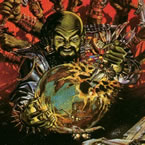This my attempt of a guide to energy, fuel, power and everything connected to it in ship and base design in DS Legends. I hope to provide comprehensive information on this topic, as there seems to be a lot of confusion around and the galactopedia doesn't explain it in all details. All info here is based on my own experimentation - feel free to comment, correct or add to this guide.
And last but not least: I'm no native speaker, so please bear with my language [;)]
1.) Basics:
you may easily skip the first two parts if you want to know directly about energy and ship design
Energy is a quantity in physics which discribes how much work a system / object (e.g. a ship) can do. The energy of a system can be "hidden" in all kinds of properties like velocity (kinetic energy) its position in a potential field (gravity, electromagnetic attraction or repulsion - so called potential energy) in the chemical composition, i.e. in the electronic conficguraion of the atoms / molecules (e.g. reaction enthalpy) and in the atmic nucleus itself (fission and fusion).
According to the believe of modern physics, energy cannot be created or destroyed, it can only be transformed from one form to another. This seems pretty intuitive but despite its called "law of conservation" its actually not something that is proven. In fact, the law of energy conservation is rooted in the invariance of the basic physics laws in time, which is actually quite in debate when it comes to times close to the "big bang". Also it is not known if the laws of physics are the same in all of the universe (its pretty big, you know). Well, lets just safely assume that energy is conserved in the scope of our galaxy and our game time.... [8D]
Power is the rate at which energy is transformed, transfered or "used". So basicly how much work can be done per time
2.) In DS:
Elliot introduced basicly 3 types of energy sources. Caslon, Hydrogen and Light.
Caslon is a fictional gas that is introduced in the game. According to DS lore it is used in nuclear fisson, i.e. the caslon nuclei are "cleaved" by fast neutrons and form fission products (smaller nuclei) and additional neutrons, creating a chain reaction. The fission products collide with other atoms and thus deaccelerate and produce heat out of their kinetic energy. This heat is usually used to create steam out of water to drive a steam turbine, which will then provide electric energy. (Yes, a nuclear reacor is basicly a big dangerous oven)
Hydrogen is the lightest element in nature. It consists of only one proton and one electron. According to DS lore it is used in nuclear fusion. In fact one can only use deuterium (proton + neutron) and tritium (proton + 2 neutrons) in fusion effectively, because the helium nucleus consists of 2 protons and 2 neutrons, and 2 hydrogen nuclei provide only 2 protons. If one does it right fusion can supply heat (out of the fast moving fusion products) that can be used for steam turbines and so on.
Light consists of photons which have an frequency dependend energy. The source is the nuclear fusion inside stelar objects named "stars". Using semiconductors (e.g. silicon or Galium-Arsenide) one can directly convert these photons into electron - hole pairs, thus electical energy. From a thermodynamical view point 100% efficiency is theoretically possible, which is a significant difference from heat engines.
3.)The Energy Display in DS Legends Ship Design
The main energy window in the ship design screen:

the values shown in the top image are:
Energy Collection: this refers to energy obtained by the energy collector component. See my notes on energy collection at the end of the post
Reactor Power Output: the total power your reactor components provide in energy units per second
Static Energy Usage: the total static power requirements in energy units per second. This value does not include power demand of weapons, shields and propulsion. Typical components that use power are life support and hab modules, labs, plants, recreation and medical and others. This power is ALWAYS consumed.
Excess Energy Output: = Reactor Power Output - Static Energy Usage. Nothing more and nothing less. Basicly the energy you have to for everything else (weapons etc.)
Fuel Type: Caslon or Hydrogen, pretty selfexplanatory
Fuel Capacity: The fuel reserve of a ship / base. see also range considerations
Energy Storage: This is tied to your reactor components. Some sort of capacitor. (would be cool if it was a component on its own) Its mainly important for combat operation. see also energy balance in combat
x fuel units per 1000 energy units: The efficiency of you reactors. If a ship base uses 1000 energy per second, it will burn x units of fuel per second (without energy collectors). Note that unused excess energy does not consume fuel - the reactors are idle, so to speak. Only real used energy (static, propulsion, charging of the capacitor etc.) burns fuel.
4.)Energy Consumption for Propulsion and Range
the Movement window:

the important part for energy are the 4 numbers next to energy below Impulse, Cruise, Sprint and Hyper.
These energy values are consumed by the propulsion for the respective drive modes.
In my example above i use 4 proton thrusters. You will find the values when summing up the energy use of the thrusters

4*2=8 for cruise
4*5=20 for maximum thrust = sprint
The energy use for an impulse is always 0.25* cuise energy
The Hyperdrive uses a fixed amount of energy for operation

The basic Gerax HD uses 78 energy. See in my above examle that i do not supply enough energy for the hyperdrive. Only 54. (see also energy window - the 54 excess energy) This is why i do not reach max speed (12500) for this ship, only 8653. I fixed the problem by adding another reactor, supplying additional 60 energy: (i also removed 3 thrusters for no reason - dont let it confuse you)

Note: Your propulsion engines have for some reason no access to the capacitor (energy storage), i.e. if you do not supply enough energy the thrusters or the hyperdrive will not use up the stored energy in the capacitor to achieve maximum speed until the capacitor has run dry. They will just run at the maximum speed shown in the movement window.
Range:
The effective range of a ship depends on several things.
- reactor efficiency Reff
- energy consumption of the hyperdrive P_HD
- maximum velocity of the hyper drive v_HD
- fuel capacity FC
- the total static energy usage P_stat
the maximum range is
range = v_HD * (FC * 1000)/((P_HD + P_stat)* Reff )
example: Gerax HD: v_HD=12500, P_HD=78
2 standard fission reactors Reff=3.81
1 standard fuel cell: FC=60
static energy use P_stat=77
range = 12500 * (60*1000)/(3.81*(78+7)) = roughly 2.3 million space units
This number doesnt make much sense without some further knowledge:
A sector is 2 million space units wide. So the ship above has a range of 1.15 sectors.
range in sectors = v_HD * (FC * 1000)/((P_HD + P_stat)* Reff * 2000000 )
the range of a ship designed like the example

5.)Energy Balance in Combat
In combat adding to propulsion two new sources of energy demands appear. Weapon fire and shield regeneration.
The main difference between these two energy eaters and the others is there use of the stored energy (if available) in the capacitor.
Here a scheme how the flow is:
Reactors + Collectors excess power >>>> Capacitor energy >>>>> Weapons + Shields
the capacitor display

When the capacitor is empty, it is charged by excess power you have with exactly the rate of the excess power. (if you have 20 excess power, than the energy in the capacitor increases by 20 per second until its full) This process uses fuel according to the reactor efficiency (if you have no energy collection).
Lets start with shields as they are simple to understand:
the defense window:

important here is only the total shield recharge rate, which is the shield recharge rate of one shield component times the number of shield omponents
recharging 1 shield point costs 1 energy, so a recharge rate of 0.9 equals an energy consumption of 0,9 energy per second. This needs to be supplied by the capacitor. So assuming we have 0 excess energy but a full capacitor, then the stored energy in the capacitor would reduce by 0,9 per second.
If you have excess energy the capacitor is recharged in parallel. So if the capacitor recharge rate (excess power)is higher than the shield recharge rate you will not see any change in the capacitor energy. However fuel is consumed to provide the nevertheless used energy.
If the capacitor is empty and your shield recharge rate is higher than your capacitor recharge rate you can only recharge your shields at the rate you provide energy. For example your excess energy is 2, your shield recharge rate is 3. Shields will recharge at the rate of 3 until the capacitor is empty (the capacitor energy is reduced by 2-3=-1 per second). Once the capacitor is empty shields will only recharge by 2 per second and the capacitor stays empty. Once shields are recharged excess energy is used to recharge the capacitor at a rate of 2 per second.
Weapons
Weapons use energy out of the Capacitor per shot. To understand weapon energy usage you need to look at two values:
- weapon energy used
- fire rate

the maxos blaster for example uses 12 energy per shot and fires once every 1.24 seconds
so the energy use per second is 12/1.24 = 9.67 energy per second = approximately 10
this is the value you will see in the weapon window as "Maximum Weapons Energy use per second"

note that the exact values are used for this calculation as the example with 4 maxos blasters shows:
4*9.67 = 38.68 = approximately 39

As with shields the energy is first substracted from the capacitor. If you have higher excess energy than maximum weapon energy used you will see the energy of the capacitor shortly reduce for the amount needed for a shot. It is than quickly recharged. The total energy balance is positive, tha capacitor will stay almost filled on average. If the excess energy is too low, the capacitor energy will start to reduce because it is not recharged quickly enough. Once its almost empty a weapon will only fire if there is enough energy in the capacitor, thus limiting the fire rate effectively by the recharge rate of the capacitor.
Keep in mind that in a real battle a ship needs to move (sprint), recharge lost shields and fire weapons. All these energy demands have to be met by the excess energy to achieve optimal performance.
6.)Energy Collection
A good way to meet energy demands of stationary objects are energy collectors. Energy collectors only provide energy while standing still and in systems. On ships they are somewhat usefull to reduce the fuel consumption caused by the static energy demands (only while ships are parked in a system though).
The energy collector works essentially like a reactor. The energy it provides is added to the total produced energy, but is not displayed in the energy window. Collected energy is also used to charge the capacitor. In this way energy collectors may provide the energy needed for weapons and shields of stations. However the exact energy provided by one collector depends on the position in the system, i.e. the distance from the star.
The value given in the component description is probably a scaling factor (i didnt test that yet). The collected energy depends lineary on the distance from the star. Maximum collection rate is at the top of the star. At the system border (where the game shows the circle, when you select a system) the collection rate is 0. Different satrs provide different amounts of energy (see graph below). Strangely enough the main sequence star provides the least energy of all starts. The black hole provides energy even outside its borders (i'm not sure where the cutoff is located). Super Novae provide energy - i still investgate the details. Gas Clouds also provide energy like a normal star (i only testet the oxygen gas cloud though)
This image shows the collection rate for 1 normal energy collector (24 potential energy)

/physics rant on: This is not a proper physical model! The surface of a sphere increases with the distance squared. Therefore the energy collection rate should decrease as 1/(distance*distance), assuming isotropic light emission. I demand this to be corrected in future versions of the game!!! physics rant off
Conclusions
I hope this guide is somewhat helpful for everyone with "energy problems". Comments, critics and further contributions are welcome.
The only thing left is to wish you all happy ship designing.
regards Sylian
















